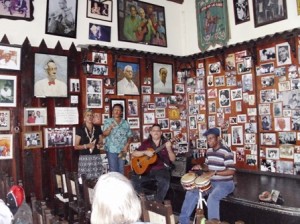La Casa de la Trova in Santiago de Cuba
Photo Feature by Dariela Aquique

HAVANA TIMES, Nov. 10 — Santiago de Cuba is the mother of a peculiar musical style known as “Trova”. From exquisitely conceived and crafted lyrics to the most improvised refrains behind the taut wire stings, the male and female musicians accompanied by a guitar made famous internationally the repertoire of traditional Cuban trova and Santiago trova as the most distinctive of its sound.
The Casa de la Trova is the place where this renowned style can always be found. Foreign musicians, curious visitors or excursionists who visit the city are a common fixture. Listening to an arpeggio of chords and the singing of classic songs of traditional folk music —they sip a Mojito, a Cuba Libre or a foamy beer to appease the eastern Cuban heat.
Having their roots in this club are native bards of the region as illustrious as Jose (Pepe) Sanchez, the great Sindo Garay, the unique Hierrezuelo Brothers and the Matamoros Brothers, and the famed Francisco Repilado (better known as “Compay Segundo” of Buena Vista Social Club fame). They and many others seem to be right here in this club at the corner of Heredia and St. Felix.
At first it was a tiny cafe there on Heredia Street, between a cafeteria and the La luz de Oriente nightclub, which became La Casa del Estudiante after the revolution in 1959. The then greasy spoon — with a bar, a few tables and a jukebox — was the meeting place for roaming minstrels who sang trova music, and because of that it took the name “La Trovita.”

Back in the late 80’s it was decided to expand the place by combining it with the old cafeteria and back rooms on the upper floor to make the facility a single-use building, the current “Casa de la Trova” of Santiago de Cuba.
Great personalities from all over the world have come to visit the birthplace of traditional trova. But none of these visits have had more of an impact than the surprise arrival on one Sunday afternoon in June 2000. People began running around all over the place telling others who they had run into:
“Paul McCartney is at the Casa de Trova,” they announced to everyone.
The former member of the Beatles, who had never visited Cuba, requested authorization from the Jose Marti International Airport in Havana to land his private plane in Santiago.
Once he landed, he visited the Santiago’s Morro Castle and then asked to be taken to the Casa de Trova. Sitting there on a bare stool he hummed along to the troubadours, signed autographs and talked about how he had always admired this kind of music, which the Beatles borrowed in some of their musical arrangements.
He left his personal gratitude to the troubadours, and that sheet of paper is preserved in a glass case hanging on one of the walls of the club along with many other signature and graffiti.
Click on the thumbnails below to view all the photos in this gallery. On your PC or laptop, you can use the directional arrows on the keyboard to move within the gallery. On cell phones use the keys on the screen.






























While I do not approve of private planes, not even for Paul McCartney, I must say on a lighter note, this article brings back many happy memories of the Casa de la Trova. May I congratulate Havanatimes for turning into Cubatimes. Havana is not Cuba.